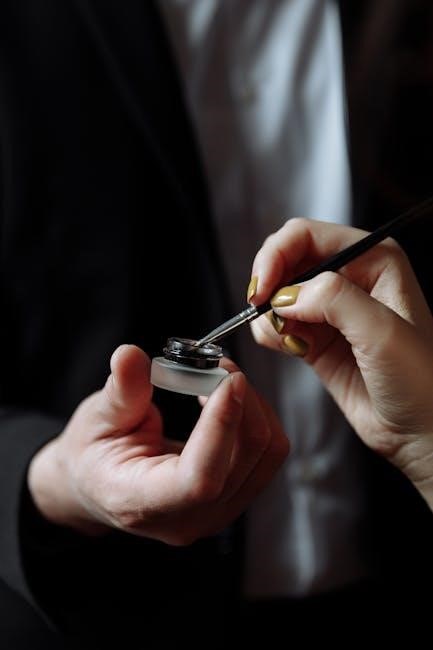Shibari, a traditional Japanese art, combines rope bondage with spiritual connection, emphasizing intimacy and control. It offers a creative way to explore power dynamics and emotional connection, accessible to all skill levels while prioritizing safety and consent.
What is Shibari?
Shibari, also known as Kinbaku, is a Japanese art of rope bondage that combines physical restraint with emotional and spiritual connection. Rooted in tradition, it emphasizes aesthetic, intimacy, and power dynamics. While often associated with BDSM, Shibari is more than just restraint—it’s a practice that fosters trust, communication, and creativity; Using ropes, practitioners create intricate patterns and binds that can be both decorative and immobilizing. Safety and consent are paramount, as Shibari involves vulnerability and control. This art form has evolved into a global phenomenon, offering a unique way to explore human connection and self-expression through the careful manipulation of ropes and techniques.
Origins and Cultural Significance
Shibari, or Kinbaku, has deep roots in Japanese culture, tracing back to the Edo period (1603–1868). Originally used for restraining prisoners, it evolved into an art form blending spirituality and sensuality. The term “Shibari” means “to tie” or “to bind,” reflecting its dual purpose of physical restraint and aesthetic expression. In traditional Japanese culture, Shibari was associated with rituals and ceremonies, symbolizing harmony and balance. Over time, it transitioned into a practice emphasizing intimacy, trust, and emotional connection. Today, Shibari is celebrated worldwide for its artistic beauty and therapeutic benefits, serving as a bridge between ancient traditions and modern self-expression.
Essential Materials for Shibari
High-quality ropes, scissors, gloves, and safety tools are crucial for Shibari. Choose durable, soft materials to ensure comfort and control during bondage practices, prioritizing safety and ease.
Ropes: Types and Qualities
Shibari ropes are typically made from natural fibers like cotton, hemp, or jute, offering durability and grip. Opt for 6-8mm thickness for balance between comfort and control. Soft, yet firm ropes ensure secure ties without chafing. Pre-treated ropes reduce stretch and maintain structure. Natural fibers allow for better grip, enhancing the bondage experience. Choose ropes in appealing colors to enhance visual appeal. Proper care, including washing and conditioning, extends rope lifespan. High-quality ropes are essential for safe and enjoyable practice, ensuring both functionality and aesthetic satisfaction in Shibari sessions.
Safety Tools: Scissors, Gloves, and More
Safety tools are essential for Shibari practice, ensuring quick releases and preventing accidents. Sharp scissors or safety shears are crucial for emergency rope cutting. Gloves provide grip and protect hands during tying. A first-aid kit is a must for minor injuries. Additional tools include rope cutters, safety knives, and quick-release mechanisms. These items ensure both physical safety and emotional well-being, fostering trust and confidence in the practice. Always have these tools readily accessible to handle any situation promptly and effectively.
Safety Precautions and Best Practices
Always prioritize circulation checks, consent, and aftercare. Ensure proper education on knots and techniques to avoid harm. Trust and open communication are foundational for a safe experience.
Understanding Safety Guidelines
Shibari requires careful attention to safety to ensure a positive experience. Always check circulation and avoid tight ropes that restrict blood flow. Consent and communication are non-negotiable, with clear safe words or signals.
Learn proper knots and techniques to prevent accidents. Regularly monitor for numbness or discomfort.
Never leave a tied person unattended, and keep safety tools like scissors nearby.
Aftercare is essential to address physical and emotional needs post-session.
Understanding these guidelines ensures trust and well-being for all involved.
Communication and Consent
Clear communication and mutual consent are the foundation of Shibari. Before beginning, discuss boundaries, desires, and any concerns. Safe words or signals are essential for immediate communication during the session.
Ensure all parties are comfortable and willing to proceed.
Active listening and respect for each other’s needs foster trust.
Consent must be ongoing and can be withdrawn at any time.
Honest dialogue ensures a safe and enjoyable experience for everyone involved.
Aftercare: Physical and Emotional
Aftercare is essential for both physical and emotional well-being post-Shibari. Gently remove ropes, checking for circulation and discomfort. Provide blankets for warmth and comfort. Emotional support is crucial; reassure and comfort the participant. Discuss the experience to ensure emotional stability. Aftercare strengthens trust and connection, fostering a positive experience for all involved.
It’s a time to reconnect and ensure all needs are met, emphasizing care and understanding. This step is vital for a safe and fulfilling practice.

Basic Knots in Shibari
Mastering basic knots like the Lark’s Head, Square Knot, and Wrap Knot is fundamental. These essential ties form the foundation of Shibari, ensuring safety and creativity.
Lark’s Head Knot
The Lark’s Head Knot is a foundational shibari tie, creating a secure and versatile starting point. It involves forming a loop with the rope’s center and slipping it over an object or limb, then tightening gently. This knot is essential for various harnesses and ties, offering a quick release option. Its simplicity makes it perfect for beginners, while its reliability ensures it’s a favorite among experts. Proper tension is key to avoid discomfort. Practice on a stationary object before applying to a partner to ensure smooth execution and safety. This knot is the cornerstone of many shibari techniques, emphasizing control and ease.
Square Knot
The Square Knot, also known as the Reefer Knot, is a simple yet reliable tie used in shibari to secure ends of rope or create a fixed anchor point. It involves crossing two strands, looping one over the other, and pulling tight to form a neat, symmetrical knot. This knot is easy to learn, making it ideal for beginners, while its effectiveness ensures its popularity among experienced practitioners. It’s often used to finish a session or join ropes together. Proper tension is crucial to prevent slippage. The Square Knot is a versatile and essential tool in any shibari practice, emphasizing both functionality and aesthetic appeal.
Wrap Knot
The Wrap Knot is a foundational shibari technique used to secure rope around a body part or object. It involves wrapping the rope around the desired area, then threading the working end through the loop created. Gently pulling tight ensures a snug, even hold. This knot is highly adaptable, suitable for various ties, from wrist and ankle bindings to more complex harnesses. Its simplicity makes it a favorite for beginners, while its effectiveness ensures its use by advanced practitioners. The Wrap Knot is key to creating secure, comfortable ties and is often combined with other knots for more intricate designs. Proper tension is essential to avoid discomfort or constriction.

Step-by-Step Tutorials for Beginners
Beginners can master shibari through easy-to-follow tutorials, starting with essential ties like the Single Column and Double Column. Clear instructions ensure safety and confidence.

Single Column Tie
The Single Column Tie is a fundamental technique in shibari, ideal for securing a single limb or object. It involves wrapping the rope around the chosen area, typically twice, ensuring a snug yet comfortable fit. The process begins by locating the bight of the rope, then encircling the wrist or ankle above the joint. Proper tension is key to avoid constriction, allowing room for fingers to slide underneath. This tie is a crucial starting point for beginners, teaching essential control and safety practices. Its simplicity makes it versatile for various applications in rope bondage, fostering confidence in both the rigger and participant.
Double Column Tie
The Double Column Tie is a foundational shibari technique used to secure two columns, such as wrists or ankles, together. It builds on the Single Column Tie, offering greater stability and control. To begin, loop the rope around each column twice, maintaining even tension. Cross the ropes between the columns and pass them under to form a secure knot. This tie is versatile, suitable for both beginners and experienced practitioners, and is often used in more complex patterns. Proper application ensures comfort and safety, making it a key skill for exploring advanced bondage techniques while emphasizing care for the participant’s well-being.

Advanced Shibari Techniques
Advanced shibari techniques involve intricate patterns and complex knots, requiring precision and practice. They enhance sessions with elaborate designs, deepening emotional and physical connections safely and artistically.
Chest Harness Weave
The chest harness weave is a classic shibari technique that combines elegance and functionality. It involves creating a series of interconnected loops and knots that wrap around the torso, often incorporating box ties and parallel girths. This pattern is not only visually striking but also serves as a foundation for more complex designs. To begin, the rigger ties a central knot at the back, then weaves the ropes around the body, ensuring even tension and comfort. Properly applied, the chest harness provides stability while allowing for dynamic movement. It’s a must-learn for intermediate practitioners, offering a balance of artistry and practicality. Practice is key to mastering this timeless technique.
Futomomo and Mermaid Ties
Futomomo and mermaid ties are advanced shibari techniques that create visually stunning and intricate patterns. The futomomo tie involves wrapping ropes around the legs and hips, forming a decorative “pants” structure, while the mermaid tie flows seamlessly from the chest to the legs, resembling a mermaid’s tail. Both ties emphasize fluidity and grace, blending functionality with artistic expression. These techniques are ideal for experienced practitioners, as they require precise control and understanding of rope dynamics. They are often used in performances and photographic art, showcasing the beauty of shibari. Mastering these ties enhances creativity and connection, making them a cornerstone of advanced practice.
Mastery of shibari requires patience, practice, and a deep understanding of safety and consent. This tutorial has guided you through essential knots, ties, and techniques, from basic to advanced. Remember, shibari is not just about rope—it’s about connection, trust, and artistic expression. Always prioritize your partner’s comfort and well-being, and continue learning through resources and community engagement. With dedication, you can unlock the full potential of this ancient art, creating meaningful and beautiful experiences. Embrace the journey, refine your skills, and let shibari enrich your life with its unique blend of intimacy, creativity, and craftsmanship.
